Yoga offers a powerful approach to enhance flexibility, build strength, and cultivate mindfulness. Focus on foundational practices like stretching and specific poses to improve flexibility. Engage in key poses such as Downward Dog and Warrior II to boost muscle strength. Incorporate techniques like breath awareness and meditation to deepen mindfulness during your practice.
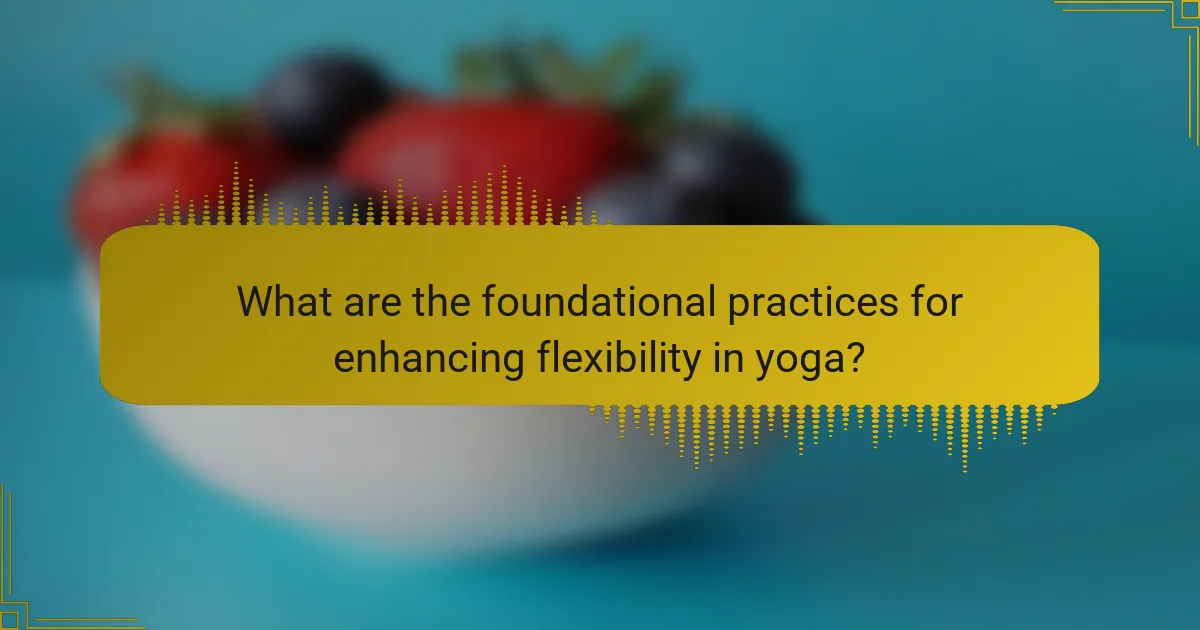
What are the foundational practices for enhancing flexibility in yoga?
To enhance flexibility in yoga, focus on foundational practices such as regular stretching, mindful breathing, and consistent practice of specific poses. Incorporating dynamic movements like sun salutations can also promote flexibility.
Key poses that enhance flexibility include downward dog, pigeon pose, and forward bends. Practicing these poses with proper alignment and duration increases muscle elasticity and joint mobility.
Mindfulness during practice fosters a deeper connection to body awareness, enhancing the effectiveness of flexibility training. Consider integrating restorative yoga sessions to complement active flexibility work.
Consistency is vital; aim for daily practice to see significant improvements in flexibility over time.
How do specific poses contribute to increased flexibility?
Specific yoga poses enhance flexibility by stretching targeted muscle groups, promoting greater range of motion. Poses like Downward Dog and Pigeon stretch the hips and hamstrings, while Cobra and Cat-Cow improve spinal flexibility. Regular practice leads to increased muscle elasticity and joint mobility, contributing to overall physical wellness. Additionally, deeper breathing during poses supports relaxation, allowing muscles to release tension more effectively.
Which muscle groups are targeted by flexibility-focused yoga poses?
Flexibility-focused yoga poses primarily target the major muscle groups including hamstrings, quadriceps, hip flexors, and spinal muscles. These poses enhance muscle elasticity and joint range of motion, promoting overall physical flexibility. Additionally, some unique poses specifically engage the shoulders and chest, contributing to upper body flexibility. Regular practice can lead to improved balance and posture, benefiting overall well-being.
What role does breath play in flexibility during yoga?
Breath plays a crucial role in enhancing flexibility during yoga by promoting relaxation and focus. Proper breathing techniques, such as diaphragmatic breathing, help to release tension in muscles, allowing for deeper stretches. As a result, practitioners can achieve greater range of motion. Breath also serves as a guide, synchronizing movement and enhancing body awareness. This connection between breath and movement fosters mindfulness, which is essential for maximizing the benefits of yoga practices aimed at flexibility.
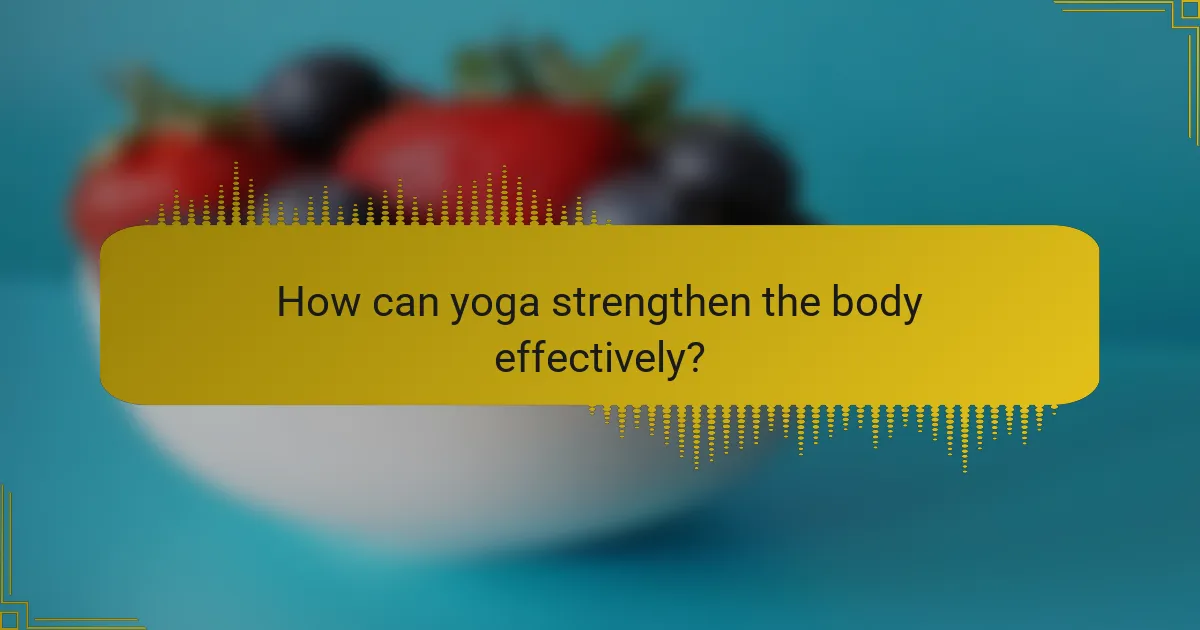
How can yoga strengthen the body effectively?
Yoga effectively strengthens the body by enhancing flexibility, building muscle strength, and promoting mindfulness. Regular practice targets various muscle groups, improving core stability and overall physical endurance.
Key yoga poses like Downward Dog and Warrior II specifically engage multiple muscles, contributing to increased strength. Research indicates that consistent yoga practice can lead to a 20% improvement in muscular strength over time.
Mindfulness, a unique attribute of yoga, aids in mental focus and stress reduction, further enhancing physical performance. This holistic approach not only builds strength but also fosters a deeper connection between body and mind.
Incorporating yoga into a fitness routine provides a balanced method for achieving physical strength while cultivating mental clarity and emotional resilience.
What are the key strength-building poses in yoga?
Key strength-building poses in yoga include Warrior II, Plank, Chair Pose, and Bridge Pose. These poses enhance muscle strength, stability, and endurance. Warrior II strengthens legs and core, while Plank builds upper body strength. Chair Pose engages the thighs and core, and Bridge Pose targets the back and glutes. Integrating these poses into practice can significantly improve overall strength and stability.
How do variations of poses impact strength development?
Variations of yoga poses significantly enhance strength development by targeting different muscle groups and improving overall body alignment. Each pose variation engages specific muscles, promoting balanced strength and flexibility. For instance, transitioning from a basic plank to a side plank increases core engagement and stability. Additionally, incorporating dynamic movements like sun salutations builds endurance and strength through continuous flow. This approach not only strengthens muscles but also enhances mind-body connection, resulting in improved performance in both yoga practice and daily activities.
What is the significance of core strength in yoga practices?
Core strength is crucial in yoga practices as it enhances stability, improves posture, and supports balance. A strong core enables practitioners to perform poses with greater ease and reduces the risk of injury. This foundational strength facilitates deeper engagement in mindfulness and breath control, essential components of yoga. As a result, individuals can experience more effective stretching and strengthening benefits, ultimately leading to a more fulfilling practice.
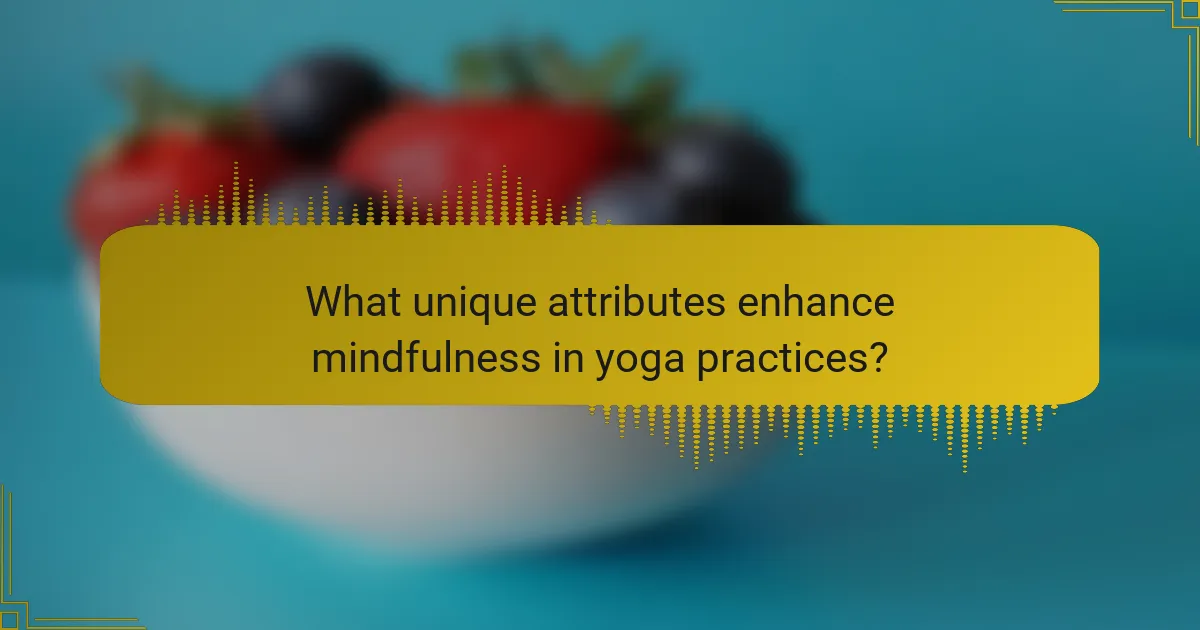
What unique attributes enhance mindfulness in yoga practices?
Unique attributes that enhance mindfulness in yoga practices include breath awareness, body scan techniques, and the integration of meditation. Breath awareness cultivates present-moment focus, while body scan techniques promote a deep connection with physical sensations. Meditation integration fosters mental clarity and emotional balance, creating a holistic approach to mindfulness. These attributes collectively deepen the practitioner’s experience, enhancing both mental and physical well-being.
How does the integration of meditation techniques influence yoga?
The integration of meditation techniques significantly enhances yoga by promoting deeper mindfulness and focus. Meditation cultivates mental clarity, allowing practitioners to connect more profoundly with their physical movements. This synergy improves flexibility and strength by fostering a relaxed state that encourages deeper stretches. Additionally, meditation aids in stress reduction, which can lead to better overall performance in yoga practices. The unique attribute of combining these techniques results in a holistic approach that benefits both the mind and body.
What are the benefits of mindful breathing during yoga sessions?
Mindful breathing during yoga sessions enhances relaxation, focus, and overall well-being. It improves oxygen flow, which boosts energy levels and aids in muscle recovery. Mindful breathing also promotes mental clarity, reducing stress and anxiety. Additionally, it deepens the mind-body connection, allowing practitioners to achieve greater flexibility and strength during their poses.
In what ways can yoga enhance mental clarity and focus?
Yoga enhances mental clarity and focus through various practices that promote mindfulness and concentration. Techniques such as breath control, meditation, and specific postures increase awareness and reduce distractions.
Regular yoga practice has been shown to improve cognitive function. A study indicated that individuals who practiced yoga exhibited better attention and memory retention compared to those who did not.
Mindful breathing techniques in yoga can activate the parasympathetic nervous system, leading to reduced stress and enhanced focus. This physiological response fosters a calm mind, allowing for greater clarity in thought processes.
Incorporating yoga into daily routines can create a unique attribute of improved mental resilience. Practitioners often report heightened levels of concentration and the ability to maintain focus on tasks for extended periods.
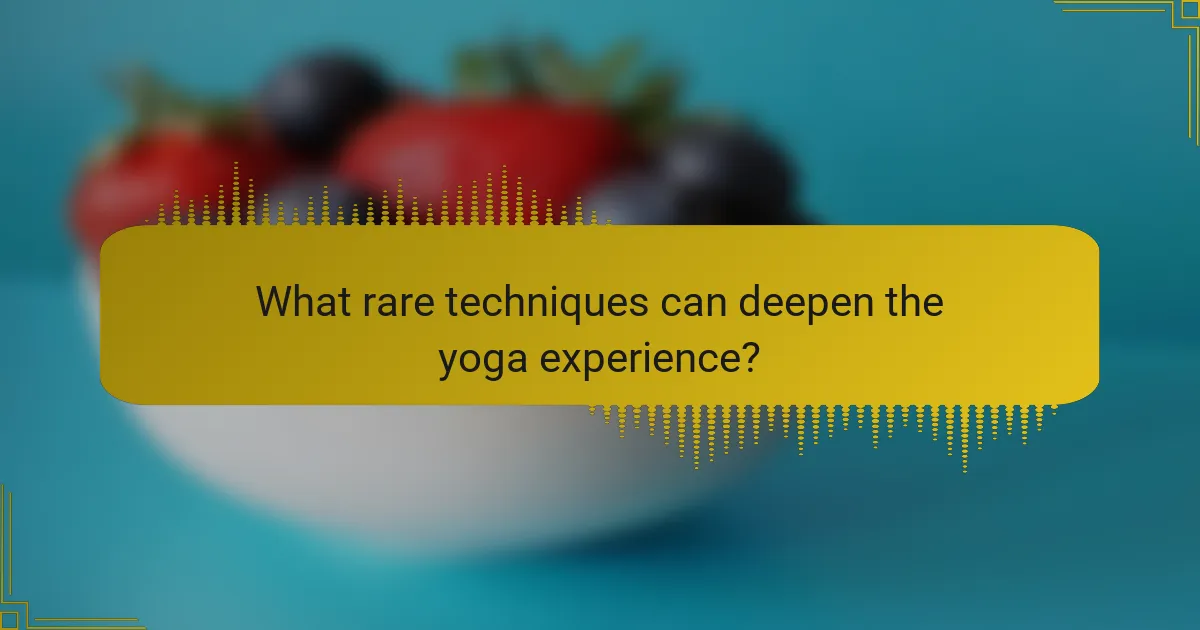
What rare techniques can deepen the yoga experience?
Rare techniques that can deepen the yoga experience include sound healing, breathwork variations, and guided visualizations. These methods enhance mindfulness and connection to the body. Sound healing uses specific frequencies to promote relaxation and focus, while breathwork variations like pranayama can elevate energy levels and awareness. Guided visualizations foster mental clarity and emotional release, offering a unique attribute to traditional yoga practices. Integrating these techniques can lead to profound personal transformation and a richer yoga journey.
How do advanced poses challenge both flexibility and strength?
Advanced yoga poses challenge both flexibility and strength by requiring the body to engage multiple muscle groups simultaneously. These poses often demand a greater range of motion, which enhances flexibility, while also requiring significant muscular effort to maintain balance and stability. For instance, poses like the handstand or advanced backbends stretch various muscle groups while strengthening the core, arms, and legs. This dual challenge fosters a deeper connection between physical capabilities and mindfulness, promoting overall well-being.
What unique props can enhance yoga practice for flexibility and strength?
Yoga props that enhance flexibility and strength include blocks, straps, bolsters, and wheels. These tools support proper alignment and deepen stretches, improving overall practice.
Blocks offer stability and help reach ground during poses, increasing flexibility. Straps assist in extending reach for challenging poses, enhancing strength. Bolsters provide support for restorative poses, promoting relaxation and flexibility. Wheels facilitate deeper backbends and core strength training, making them unique in their ability to challenge balance and strength.
What uncommon practices can elevate mindfulness in yoga?
Uncommon practices that elevate mindfulness in yoga include breathwork techniques, sensory awareness exercises, and integrating nature. Breathwork, or pranayama, enhances focus and presence during practice. Sensory awareness exercises, such as mindful listening or tactile exploration of the mat, deepen the connection to the body. Practicing yoga outdoors fosters a unique environment that encourages a heightened sense of awareness.
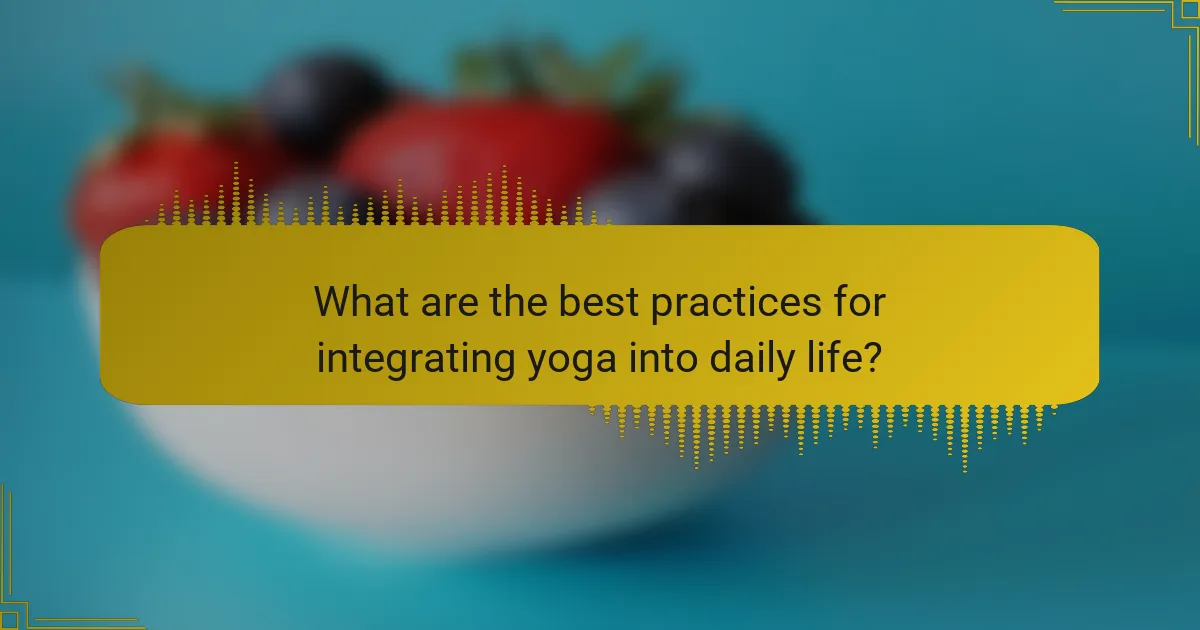
What are the best practices for integrating yoga into daily life?
Integrating yoga into daily life enhances flexibility, strength, and mindfulness. Start with a consistent schedule, dedicating time each day for practice. Incorporate short sessions throughout the day to maintain engagement and focus. Use yoga apps or online videos for guidance and variety. Create a dedicated space for practice to foster a calming environment. Set specific goals, such as improving a pose or increasing meditation duration, to track progress. Engage with a community or group for motivation and support.
How can one create a balanced routine for flexibility, strength, and mindfulness?
Creating a balanced routine for flexibility, strength, and mindfulness involves integrating yoga practices that focus on these elements. Start with a combination of dynamic stretches to enhance flexibility, strength-building poses like Warrior and Plank, and mindfulness techniques such as breath awareness and meditation. This holistic approach fosters physical and mental well-being. For optimal results, practice regularly, ideally 3-5 times a week, to cultivate lasting benefits in all three areas.
What common mistakes should be avoided in yoga practices?
Common mistakes in yoga practices include improper alignment, overextending poses, ignoring breath, and skipping warm-ups. These errors can lead to injuries and hinder progress in flexibility, strength, and mindfulness. Practicing mindfulness and listening to your body can help avoid these pitfalls. Additionally, seeking guidance from qualified instructors enhances safety and effectiveness in yoga.
What expert tips can optimize your yoga journey?
To optimize your yoga journey, focus on consistency, proper alignment, and mindfulness. Establish a regular practice schedule that fits your lifestyle. Prioritize alignment to prevent injuries and enhance effectiveness. Incorporate mindfulness techniques, such as breath awareness, to deepen your experience and connection with your body. Consider exploring various styles of yoga to find what resonates best with you.